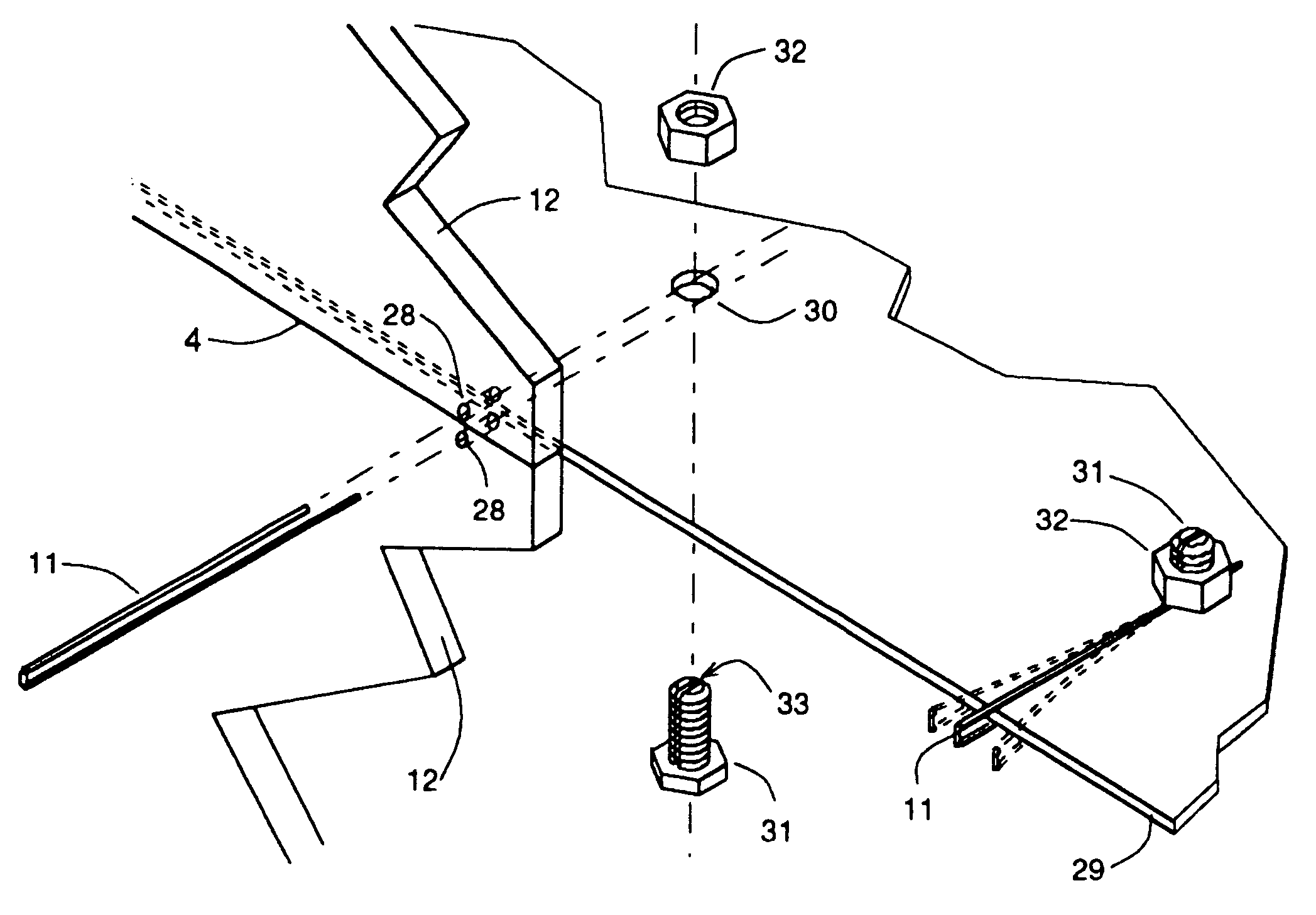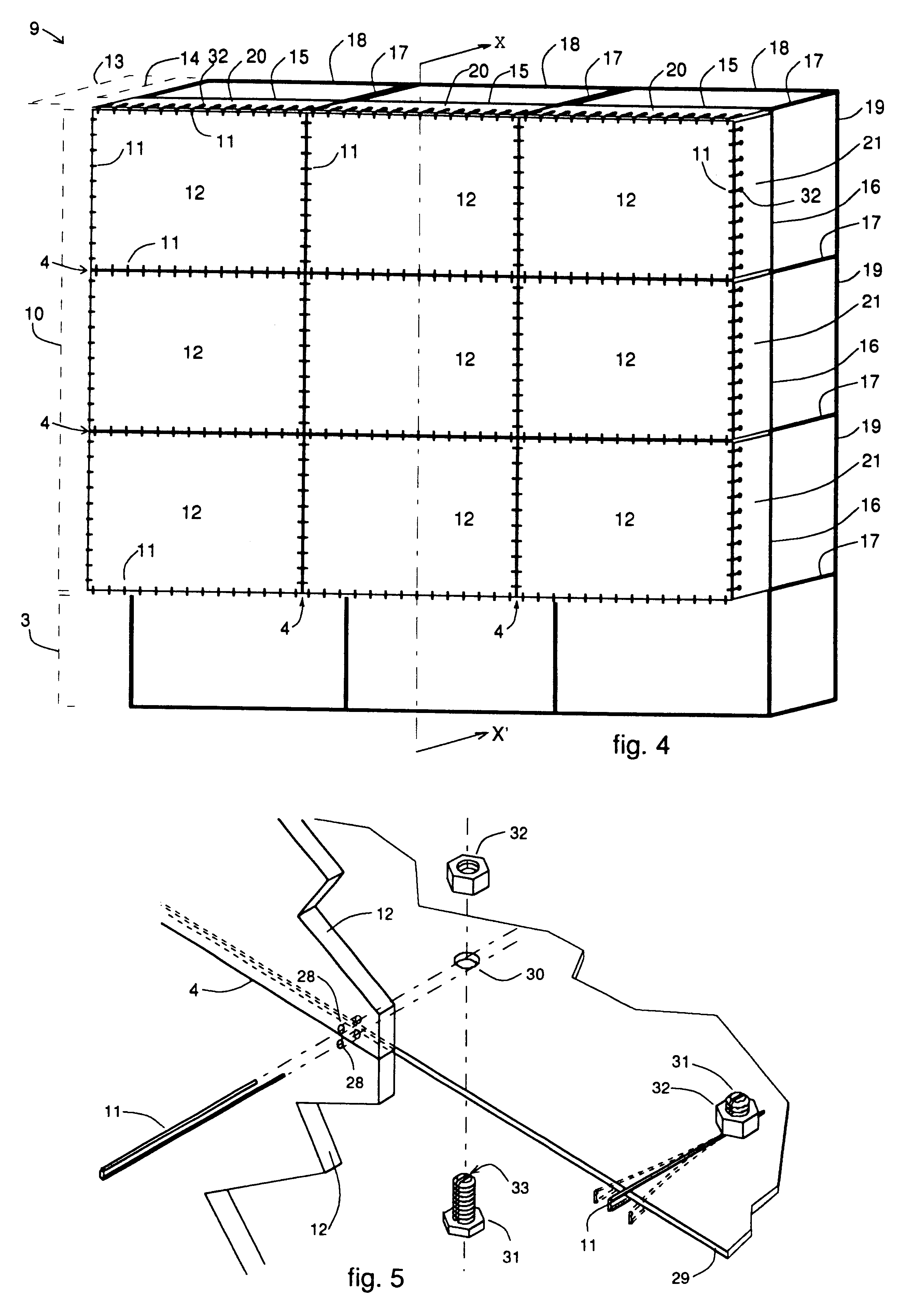Projection screen for image reproduction devices which are positioned next to and/or above one another
a technology of projection screen and image, which is applied in the direction of instruments, television systems, optics, etc., can solve the problems of affecting the connection between, affecting the distance between the basic units, and fragile edges of the basic units of this natur
- Summary
- Abstract
- Description
- Claims
- Application Information
AI Technical Summary
Benefits of technology
Problems solved by technology
Method used
Image
Examples
first preferred embodiment
A single extruded section is used for the horizontal and vertical profile sections 15, 16; the horizontal profile sections 15 are longer than the vertical profile sections 16.
FIG. 12 shows the intersection between two horizontal profile sections 15, two vertical profile sections 16 and a lateral profile section 17. The horizontal and vertical profile sections 15, 16 present two longitudinal slots on the front side, namely a central slot 25 for the attachment of a vertical attachment plate 21 and a lateral slot 26 for the attachment of a horizontal attachment plate 20. A T-slot is provided on the rear side of the horizontal and vertical profile sections 15, 16 for fixing these profile sections 15, 16 to a lateral profile section 17 via attachment elements 27 and using coach bolts and nuts as described in BE-9601054. This lateral profile section 17 differs from the horizontal and vertical profile sections 15, 16 in that it is substantially square in cross-section, and that it has at l...
second preferred embodiment
FIG. 17 shows the intersection between two horizontal profile sections 15, two vertical profile sections 16 and a lateral profile section 17. A single extruded section is used for the horizontal, vertical and lateral profile sections 15, 16 and 17. In this second preferred embodiment, the horizontal profile sections 15 are longer than the vertical profile sections 16 to obtain an aspect ratio of 4 / 3. The profile sections 15, 16, 17 have four equal sides in which a T-slot is provided for fixing profile sections to one another or for the fixation of other items to the profile sections. At the location where horizontal and vertical profile sections 15, 16 come together at an intersection as shown in FIG. 17 or at an edge of the projection screen 9, the horizontal and vertical profile sections 15, 16 are all fixed to the same lateral profile section 17 via attachment elements 27 and using coach bolts and nuts as described in BE-9601054.
second embodiment
The second embodiment differs from the first embodiment in the attachment plates 20, 21, the profile sections 15, 16, 17 and the attachment between said attachment plates 20, 21 and said profile sections 15, 16, 17. The screen panels 12 and their attachment to one another and to attachment plates 20, 21 by means of joining wires 11, and the joining wires 11 themselves are identical for both preferred embodiments, and therefore is referred here to the description of these common and identical parts of both embodiments in the description of the first embodiment.
FIG. 18a shows the two parts of a horizontal attachment plate 20, being a top metal plate 68 and a bottom metal plate 69.
The bottom metal plate 69 has two perpendicular planes, being a plane 70 and a raised edge 71. In the raised edge 71 are holes 72 for the fixation of the bottom metal plate 69 to the supporting structure 13 e.g. by means of bolts 66 and nuts 67 as shown in FIG. 17. In the plane 70 of the bottom metal plate 69...
PUM
 Login to View More
Login to View More Abstract
Description
Claims
Application Information
 Login to View More
Login to View More - R&D
- Intellectual Property
- Life Sciences
- Materials
- Tech Scout
- Unparalleled Data Quality
- Higher Quality Content
- 60% Fewer Hallucinations
Browse by: Latest US Patents, China's latest patents, Technical Efficacy Thesaurus, Application Domain, Technology Topic, Popular Technical Reports.
© 2025 PatSnap. All rights reserved.Legal|Privacy policy|Modern Slavery Act Transparency Statement|Sitemap|About US| Contact US: help@patsnap.com



